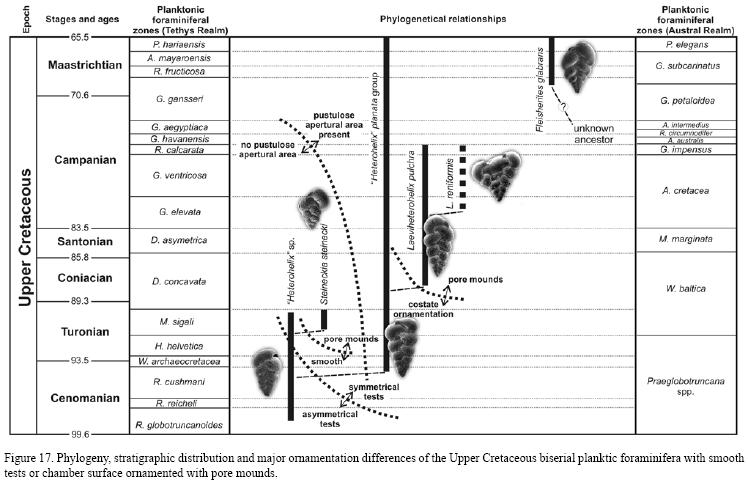
A stratophenetic-type diagram showing possible relationship between selected late Cretaceous planktonic foraminifera.
From Georgescu, 2009 fig.17
| Stratigraphy and phylogeny | ||
| Systematics | Stratigraphy and phylogeny |
| Molecular phylogeny | Systematics | Phylogenetics |
Phylogeny and Systematics |
Stratigraphy and phylogeny |

|
| A stratophenetic-type diagram showing possible relationship between selected late Cretaceous planktonic foraminifera. From Georgescu, 2009 fig.17 |
In mapping out the evolutionary tree of life on Earth, we have at least three fields of data at our disposal - gross morphology, the genome, and the fossil record - along with others such as developmental biology, biogeography, and so on. Of the first three named, comparison based on gross morphology, whether obvious shared characteristics (synapomorphies) or statistical parsimony or other computational analyses, is the basis of Cladistics (Phylogenetic systematics). Comparison of the sequence of genes in the DNA and RNA, and proteins and other molcules in the cell, constitutes molecular phylogeny. And understanding life in terms of the fossil record (the sequence of fossils according to younger or older rock strata) is stratigraphic phylogeny.
At one time, the stratigraphic sequence of fossils were essential to understanding the evolutionary relationships of life on Earth. This field of phylogeny is called Evolutionary systematics, and was grounded firmly in paleontology. The cladistic revolution of the 1980s and 90s was an attempt to introduce greater rigor, objectivity, and methodological uniformity and testability into phylogeny. But because cladistics as originally formulated was (and still in large part is) grounded in, on the one hand, neontology, and on the other, the comparison of characters abstracted from temporal and geographic location (i.e. from where the fossils were really found in time and space), temporal or stratigraphic (as well as geographic and paleogeographic) information was considered irrelevant. Inconsistencies between cladograms and stratigraphic sequence in the fossil record (known as stratigraphic incongruencies) were based on the ad hoc assumption that the fossil record (even for well sampled and easily preserved taxa) is so incomplete as to be absolutely useless for anything other than supplying some extinct taxa for analysis.
By rejecting stratigraphy, mainstream cladistics also limits itself more than it needs to; it has never empirically disproved stratocladistics - the retention index for stratigraphic data is not statistically different to that for morphological data (Levinton, 2001, p.78), so there is no reason why stratigraphy cannot be taken into account when constructing cladograms, other than that it is not included in the traditional set of problem-solving methodologies (Kuhn, 1962) used by the mainstream, cladistic paradigm.
If we assume that the fossil record does contain useful phylogenetic information, then we are faced with the problem of how to reconcile cladistic analysis with the temporal and stratigraphic information provided by the fossil record, in those instances where they conflict (for example, where the more derived taxa appear earlier than the more basal or stem taxa). There are three possible options here (this list is from Principals of Phylogenetic Systematic)
Here at Palaeos we have assumed the third option as the default one. As a result, our phylogenies may sometimes differ in details from the official ones. In all these instances, reasons for the new phylogeny or choice of dendrogram is explained.
A few words about molecular phylogeny and stratigraphy. Molecular phylogeny, like the fossil record, frequently conflicts with parsimony-based analyses. In these instances however, phylogenists almost universally reject parsimony, even though the resulting tree topologies are often ridiculous. In the case of mammals, many molecular phylogeny derived clades are unsupported by any synapomorphies at all. In these instances, we have assumed that molecules can at times be unreliable and contain artifacts and convergences just as gross morphology does. Therefore, although molecular phylogeny may provide many useful insights, that is no reason to reject morphology out of hand.
Moreover, the molecular clock is clearly not always reliable, since molecular dating of the emergence of major placental mammal contradicts the fossil record. In these sort of instances, we believe fossils should be preferred over molecules (although in other respects the two systems of data can equally support each other (Donoghue & Benton (2007)).
Summing up. Stratigraphy and stratigraphic based methodologies such as stratocladistics and stratophenetics present an important but neglected source of phylogenetic data and new hypotheses, which can help contrinute to the insights provided by both morphology-based cladistics and molecular phylogeny, and vice-versa. Further fields such as Evo-Devo and systems theory also have great potential. In teasing out the details and even the broad brush strokes of the evolutionary tree of life on Earth, each methodology has something to contribute MAK120212
page by MAK120212